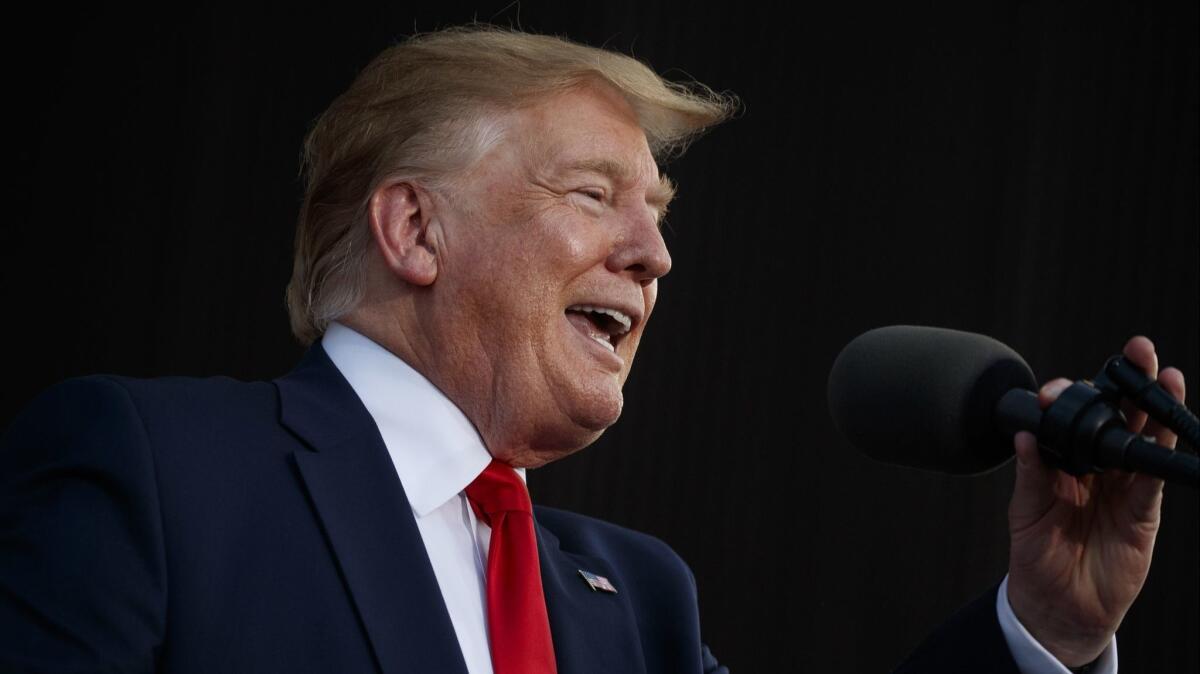Op-Ed: How can Trump get reelected? It’s still the economy, stupid

- Share via
President Trump isn’t that worried about potential impeachment hearings. He even tries to goad Democrats into starting the process, knowing that will enliven his base and distract Democrats from their legislative agenda. And he has emerged from the Mueller investigation seemingly unscathed, despite serious evidence of obstruction and unsavory behavior. The storm over Ms. Daniels has long faded way, with only her lawyer, Michael Avenatti, facing criminal charges.
Like him or not, Trump has proven to be a “Teflon president.”
As the 2020 election campaign gets underway, Trump is exuding confidence. He boasts that he can beat any of the potential challengers, including “Pocahontas,” “sleepy Joe,” “crazy Bernie,” “lightweight Kirsten” and, of course, “crooked Hillary.” He predicts that his 2020 margin of victory will exceed that of 2016.
While Trump may taunt his potential challengers and boast of easy victory, he surely harbors grave concerns about his reelection. He won in 2016 on economic issues. His promise to “Make America Great Again” reverberated with voters who had suffered through the worst post-recession recovery in U.S. history.
If the economy grows well in the first three quarters of an election year, the incumbent gets credit — and many more votes.
Now he faces a similar dilemma. Yes, the economy is doing quite well and unemployment is at historic lows — as Trump constantly reminds us. But voters have short memories. In November 2020 voters will be focused on contemporary economic conditions.
An electoral prediction model constructed by Yale University professor Ray Fair highlights Trump’s problem. The Fair model says that people do vote their pocketbooks (“It’s the economy, stupid”). Further, their votes can be predicted on the basis of only two pocketbook variables: gross domestic product growth and inflation. History has shown that this simple model is one of the best crystal balls for foreseeing the next election. It correctly predicted Trump’s 2016 win.
Based on current economic trends, the Fair model predicts a resounding victory for Trump in 2020. But trends can reverse. The problem for Trump is that voters won’t be thinking about four years of economic performance when they assess the economy in November 2020. They will be thinking about conditions earlier in the year.
If the economy grows well in the first three quarters of an election year, the incumbent gets credit — and many more votes. Fair calculates that an incumbent president picks up about two-thirds of a percentage point in the popular vote for every one point of per capita GDP growth in the first three quarters of an election year.
But if growth declines or turns negative, the same equation applies, except the president loses about two-thirds of a point in the popular vote. A president who lost the popular vote in 2016 with only a little more than 46% of the vote has to worry about such things.
Of course, electoral college math overcame Trump’s second-place popular vote. But that has happened only five times in U.S. history. Typically, the winning candidate needs at least 50% of the popular vote to win. Obama had 50.1% in 2012 and 52.9% in 2008. Bush had 50.7% in 2004. At present, the Fair model puts Trump comfortably above that threshold, with as much as 54% of the popular vote in 2020.
Trump’s apparent margin of victory can be strengthened by a few more really good quarters of economic growth. Specifically, for any calendar quarter in which economic growth exceeds the long-term average of 3.2%, the incumbent picks up an additional four-fifths of a point in the popular vote. So far, Trump has enjoyed three such “good news” quarters. They have added almost 2.4 points to his predicted vote share. Fair predicts those good quarters all but assure a Trump victory in 2020.
Enter the Fray: First takes on the news of the minute from L.A. Times Opinion »
But Trump does have something to worry about. Economic forecasters are nearly unanimous in predicting an economic slowdown as the effects of the Trump tax cuts and Fed interest rate cuts dissipate. Many economists are predicting a recession in 2020. The trade wars that Trump has initiated may also spark unwelcome price hikes. If economic growth turns negative and inflation rises, Trump’s predicted margin of victory shrinks quickly.
This economic possibility is what must worry Trump. He wants a sure thing — not an economic contingency. To get that, he needs a guarantee of continuing economic growth. How can he get that guarantee? More tax cuts would do the trick, but the Democratic-controlled House would rather raise taxes than cut them. So fiscal policy won’t do it.
What other policy lever is there? The Fed, of course. If the Fed cut interest rates again, that would give the economy another boost. But Fed policy has a long lead time. To boost economic growth in early 2020, the Fed would have to cut interest rates now. That’s why Trump and his economic team are relentlessly pressing Fed Chairman Jerome H. Powell to cut interest rates. Trump knows that Chairman Powell is more important than Chairman Xi Jingping of China to his reelection. And he knows he can always cut a deal with Xi when he needs to. But the Fed is an independent agency that has demonstrated the ability to fend off Trump’s attacks.
Trump’s 2020 nightmare is a slowing economy, benignly overseen by an independent Fed.
Brad Schiller is an emeritus economics professor at American University and author of “The Economy Today.”
More to Read
A cure for the common opinion
Get thought-provoking perspectives with our weekly newsletter.
You may occasionally receive promotional content from the Los Angeles Times.









